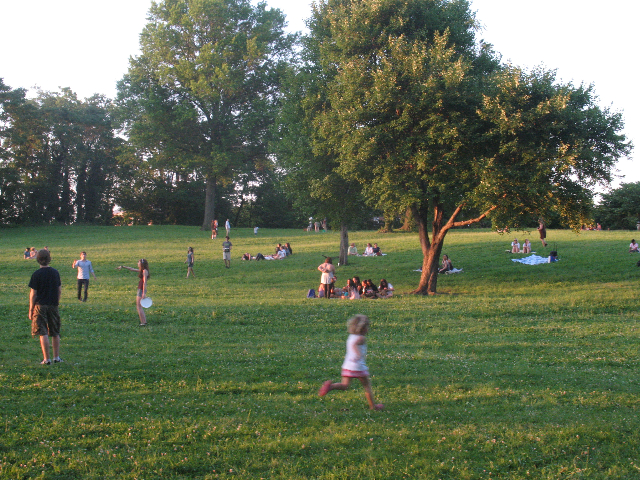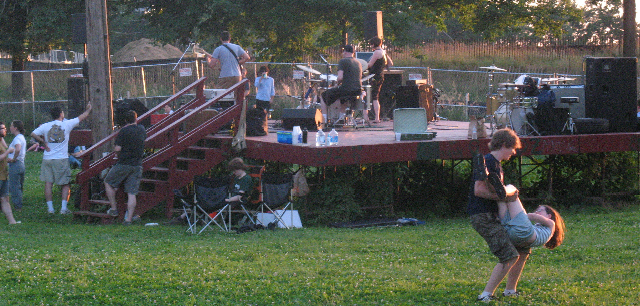
Last night began week five of this summer’s Fort Reno concerts. The annual series of musical triptychs, which take place in an improvised venue in the Tenleytown park, may be the most urbane happening of any place in DC. Amid the mild yellow-orange light of a summer evening, a small local band plays and a few hundred people of various ages watch while they sit on the grass. But beyond that and behind the stage, those less interested in the concert partake in all kinds of leisurely activity. Really, I’ve never seen the park so well used.
A couple families recline on blankets on the hill, letting their dogs and children free for a while. Mixed groups of teenagers sit in clusters and chat. One cluster plays frisbee and an all-boy group engages in a confused game of jackpot. Other toddlers and kids race around the field between the stage and the ridgeline, never going too far uphill. Even in the roughly defined audience, the outdoor configuration lets listeners sit down, lay back, converse, or eat. The music becomes a kind of public furniture, quietly settling into the aesthetic background. It’s not as though side activities don’t arise at other concerts, but the diversity and gusto of the diversions at Reno is greater than at any event I’ve ever been to.
The activities one would expect to see in a park are precisely the ones occurring in a park at a regular time. Well, that guy who’s running around in a banana costume is unusual, but it’s unfortunate that Fort Reno otherwise has only a handful of residents using it. To be fair to those who never visit the park, there isn’t much there otherwise; it’s really just an empty field with a stage, some trees, a fire hydrant, etc. Nothing special, until people start bumping into one another.

The architect Bernard Tschumi likes to call this behavior “event;” stripped of his deconstructionist jargon, the term does capture the essence of what happens: “stuff that happens.” Unlike the concert itself, which is organized “program,” event consists of all the unplanned activity that goes on in an architectural space, sort of flouting the intended form of the location. People interact amicably, randomly in a memorable environment.
For around three hours, the indistinctness of Fort Reno Park fades in the face of casual human activity. It can be unequivocally said that the concert is a place for a while. In spite of the uninteresting physical conditions, the ephemeral cultural environment draws people who feel a communion with the others around them. You don’t have to like the music, you don’t have to care about the humdrum park, you were there, at the scene. It was a place for a while.
Placemaking, as a goal of architecture is about instilling a location with a “sense of place,” really a site of distinct signifiers of human interaction. Designers like William Whyte have held that a public space ought to be lively without any kind of formal activity. I agree, but people do go to parks in part to experience others’ activity. An empty palazzo can seem grimly uninviting, but bustling with people, the same space achieves functional place. The same phenomenon occurs here, just less frequently. The music might be an incentive to come to the park, but its transformation of the grassy lot facilitates and encourages the other activities. The music becomes a kind of public furniture, around which people run and play and socialize.
Placemaking is fundamentally about human connectivity. Primarily, one wants to facilitate event by making locations inviting and enjoyable, sites in which people can entangle their lives and memories. Secondarily, placemaking involves communication by proxy through the architecture. Distinctive architecture, signage, art, and historical buildings facilitate communication passively. This kind of physical communication can let passers-by connect to those they wouldn’t otherwise speak to, such as shopowners, slices of culuture, and even the dead. The concerts facilitate both forms of communication. Like Artomatic, the Reno concerts showcase the talents of young bands: cultural communication. As at Dupont Circle, as the patrons simply enjoy the aesthetic experience of the environment and subtly communicate.
In summary, just go to a Reno concert. It’s a worthwhile experience, even when you don’t like the band. Have a picnic with friends. Throw around a frisbee. Sit back and observe. You’ll see timeless human activity instantiated in a way that suits the blankets and grass. While it will only happen three more times this summer, that temporary place at Reno is one of the best in DC, and purely because of the people there.
Thursday, July 23: Soft Power, Benjy Ferree, [TBA]
Monday July 27th: North America, Stoney Lonesome, Pree
Thursday, July 30th: Title Tracks, Casper Bangs, Grendel Babies
Also: do look for Alexandra Silverthorne’s photography installation near the stage. It’s a little damaged, but the photograph is still there. Otherwise, she’s scattered a few others in parks around northwest.
1 thought on “When a concert isn’t just that”